Rani Ki Vav is a UNESCO World Heritage located in the town of Patan in Mehsana District of Gujarat. This is a complete guide to visiting Rani Ki Vav in Patan, Gujarat, India with all the required travel info. Know all about the history, architecture, and beautiful sculptures of Rani Ki Vav here. Useful information about the entry fees, the best time to visit, what not to miss, and tips are also provided in this post.
As you approach Rani Ki Vav Patan, the first impression that you get is that of a massive, rectangular pit. The magnificence of this UNESCO World Heritage site reveals itself only as you descend downwards towards the bottom of the well, one step at a time. Each step takes you closer to the artistic genius of the craftsmen who gave shape to this marvel in stone a thousand years ago.
Join us as we delve deep into the history of Rani Ki Vav and decode its beautiful sculptures that tell riveting stories that continue to resonate from across, the frontiers of time and space.
Table of Contents
Rani Ki Vav Patan – A Requiem For A King
Rani Ki Vav or Rani ni Vav in Gujarati means Queen’s Stepwell, and this stepwell in Patan, Gujarat, India, is no ordinary stepwell. It may not be wrong to say that it is indeed the queen of step wells in India. It goes way beyond its utilitarian value and is a grand statement of the love for art and architecture of the Solanki rulers of Gujarat. It is considered to be a monument of love. The Rani Ki Vav was built by the Solanki queen, Rani Udayamati, for her deceased husband, King Bhima I.
Bhima I is known for the building of the Modhera Sun Temple and the beautiful Dilwara Temple in Mount Abu in Rajasthan. In fact Bhima I has etched his place in the annals of history as a builder and re-builder of temples. It is Bhima I who rebuilt the great Somnath Temple after its desecration and destruction by Mahmud Ghazni. He also built and rebuilt numerous Hindu and Jain temples in Gujarat and Rajasthan.
Stepwells In Gujarat
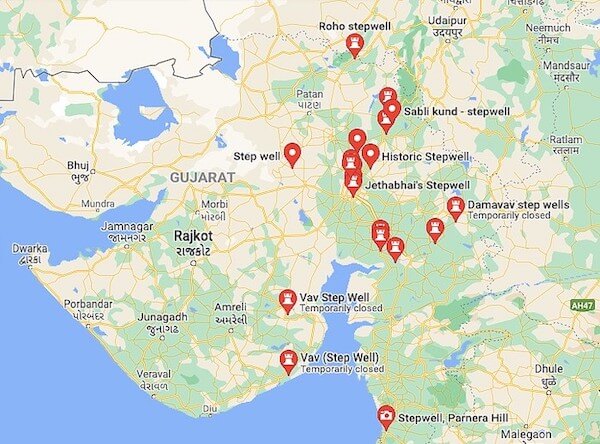
Stepwells were born out of necessity. They can be found all across the country. In Gujarat, they are known as Vavs, while in the Rajasthan and other parts of North India, they are known as Baoris. As the name suggests, step-wells are wells where the water is reached with the help of steps. The step-wells date back to the times of the Indus Valley Civilization. Remains of a stepwell have been found in the UNESCO World Heritage Site of Dholavira in Gujarat.
There are more than 120 stepwells in Gujarat. The earliest existing Step-well in Gujarat is the Navaghan Kuvo in Uparkot in Junagadh which is believed to have been built in the 4th century, another step-well called Adi Kadi Vav is located nearby and dates back to the 10th century. The popular step wells of Gujarat apart from Rani Ki Vav, are the Adalaj Vav and the Dada Hari Ni Vav in Ahmedabad.
Stepwells though initially served a very utilitarian purpose of making water easily accessible, they went on to become resting places for people, caravans, and cattle. Places that were usually near the roads, where travellers could quench their thirst, rest in the shade for some time and proceed on their way.
Stepwells gradually evolved from their utilitarian role into large canvases for the architects, artists and sculptors of the region to showcase their talents. The Rani Ki Vav in Patan in many represents the pinnacle of art and architecture seen in a stepwell and is rightly dubbed as the Queen of step-wells.
Rani Ki Vav, Gujarat History
Not far from the banks of the River Saraswati, there flourished a city variously named Anahillavada, Anahillapura, and also Anahilapataka. This city was the capital of the Solankis, also known as Chaulukyas, who held sway over regions in present-day Gujarat and Rajasthan, from 940 CE till 1244 CE. The medieval city of Anahillapura which is present-day Patan of Gujarat was the site of many historic structures including forts, temples, mosques, tombs, and tanks including the famous Sahasralinga Talao.
After the death of King Bhima I in the 11th century, this city saw the birth of another structure that would one day become the cynosure of all eyes. This was a stepwell embellished with magnificent carvings and sculptures, that came to be known as Rani Ki Vav.
It is believed that Rani Ki Vav at Patan was built by Queen Udayamati as a tribute to her husband, Bhima I sometime towards the end of the 11th century. The magnificent structure was however literally swallowed by the earth and lay buried under huge mounds of sand in the 13th century. It is also believed that the beautiful structure was flooded by the river Saraswati and silted over in the process. Accounts by the British Archaeologist, James Burgess, who visited the site in the late 19th-century talk about the site being fully buried in the earth, except for a portion of the shaft of the well towards the west and a few pillars.
The sands of time which literally buried the Rani Ki Vav for centuries proved to be a blessing in disguise as it helped preserve the structure from the vagaries of nature and marauding invaders. Rani Ki Vav was first unveiled in the 1940s during excavations. Painstaking and meticulous work that spanned several years by the Archaeological Survey of India, in the 1980s, finally revealed the full splendour of Rani Ki Vav to the world.
Rani Ki Vav Architecture & Art
Rani Ki Vav is in many ways a culmination of the ingenuity and craftsmanship involved in the building of step-wells in Gujarat and other regions of India. It is a structure that seems to transcend the very boundaries of art and sculpture.
Rani Ki Vav Plan
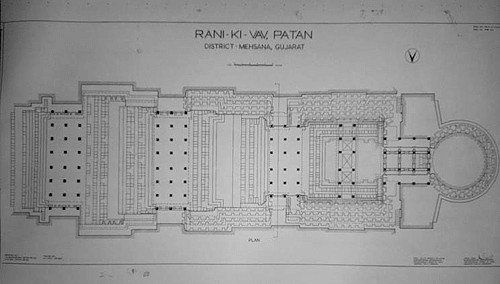
Its architectural design is akin to an inverted temple, with water as its principal deity of sorts. It is built downwards spanning seven levels or storeys from the ground level. The subterranean structure goes down to a depth of about 30 metres. Rani Ki Vav is built on an east to west axis. Towards the west is the shaft of the well which has a diameter of about 10 metres.
The entry into the stepwell was from the eastern side which probably was marked by a pillared arch or Toran, which is non-existent today. However, there were steps to enter the well from the shaft size too. The Rani Ki Vav measures about 65 metres in length from West to East, and about 20 metres wide from North to South.
In terms of size, Rani Ki Vav is massive, and when it comes to decoration, the walls of the well, the pavilions, and the pillars are richly decorated with carvings and sculptures that epitomize grace and fluidity in stone. There are about 500 principal sculptures and around 1000 subsidiary ones in the Queen’s stepwell.

Around 300 pillars are believed to have supported the pavilions of Rani Ki Vav Patan, however, today around 200 of these survive. The pillars are richly ornamented with motifs like Kalash, sculptures, and geometric designs that are similar to the ones that you can see at the Modhera Sun Temple.
The columns in Rani Ki Vav are richly carved with designs and motifs from Hindu iconography, they are also ornamented with exquisite capitals which are made up of mythical creatures including Yalis.
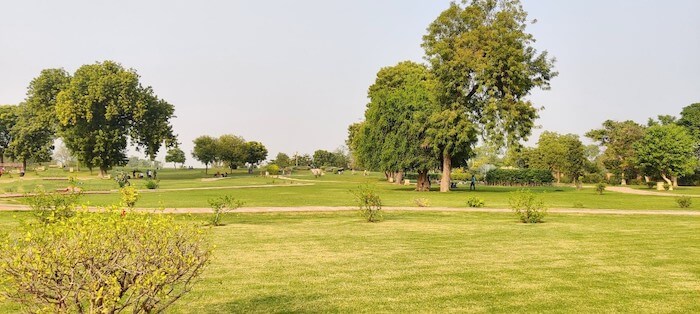
Today Rani Ki Vav is surrounded by a sprawling and lush garden. A path leads to the entrance of the stepwell from where you descend down to keep your rendezvous with the elegant and mesmerizing sculptures that have been waiting for you, for centuries.
Spectacular Sculptures of Rani Ki Vav
The Rani Ki Vav which is basically a stepwell is a marvel of engineering design, but the builders decided to ornament it so grandly, that it would stand as a testament to their genius for centuries to come. The sculptures of Rani Ki Vav are, to say the least, stunning! They have your gaze riveted with their beauty and fluidity of design, and time seems to stand still as you look at these beautiful creations in stone.
As you descend from the ground level inside the Rani Ki Vav, you will realize that the first two stages of the stepped corridor are relatively bare of sculptures and damaged. But as you descend further to the third stage, you come eye to eye with some of the most spectacular sculptures that you would ever see.
Similar to what you see on the outer walls of the Gudhamandapa at the Modhera Sun Temple, here too the sculptures can be seen arranged in three horizontal bands. The broadest of this band in the centre is where the sculptures of the main deities can be seen in niches, these are flanked by projected sculptures of Apsaras, or Dikpalas, or other forms.
Below the main central band is a band with smaller sculptures separated by a thin band of Kirtimukhas, and the central band is crowned by the third band which consists of pediments.
The sculptures in Rani Ki Vav include those of different forms and avatars of Vishnu. Different forms of the Mother Goddess and Parvati or Gauri. Shiva in different forms, Brahma, Ganesha, and others from the Hindu pantheon. Apsaras, Sages, Nagkanya, and other female sculptures also adorn the walls and pavilions of the stepwell. There is also a sculpture of Queen Udayamati herself in a seated posture. Here are some of the sculptures that can be viewed by visitors, as all the levels are not accessible.
Balarama
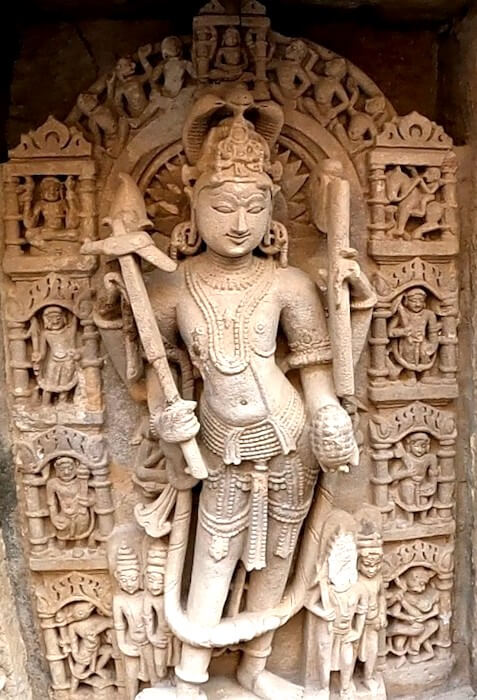
When you reach the lowest of the terraces in the third stage of the stepped corridor of Rani Ki Vav, you almost literally come face to face with some of the Dashavataras of Vishnu. They stand, beautifully sculpted in the main niches.
The first sculpture to greet you is that of Balarama, brother of Krishna in the Dwapara Yuga. Balarama is considered to be an avatar of Vishnu as well as a manifestation of Sheshnag. Balarama stands with four hands, each hand holding a plough, lotus, citron fruit and pestle respectively. The hood of the snake Sheshnag can be seen over his head. He stands with legs slightly apart, the weight of his body borne more by his left foot.
Parashurama
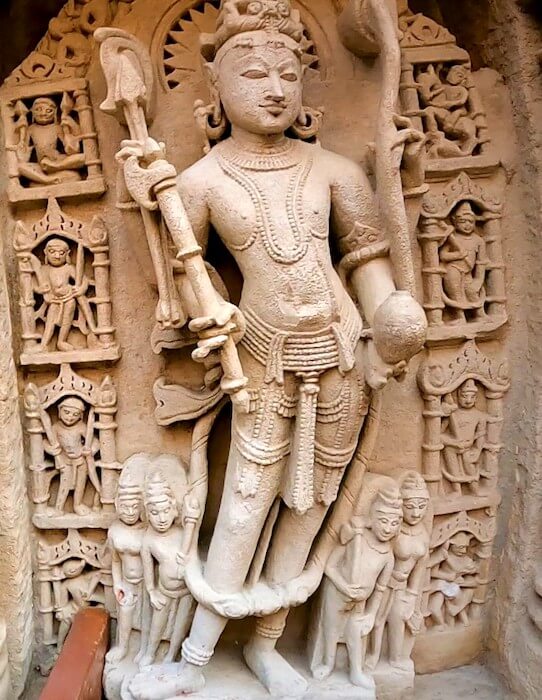
Standing next to Balarama is Parashurama, the sixth incarnation of Lord Vishnu. He is depicted with four hands. One hand holds a battle-axe, one holds a bow, one an arrow, and one what seems to be either coconut or a Citron fruit.
Buddha
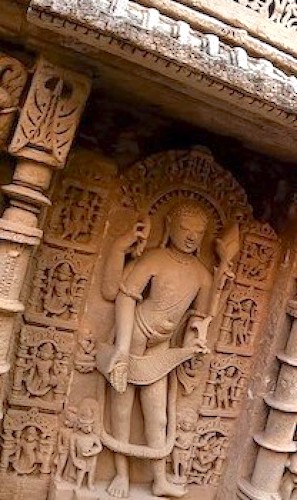
In many traditions, Balarama is replaced by Buddha in the list of 10 avatars of Vishnu. However, it is interesting to note the presence of both Balarama and Buddha among the sculptures in Rani Ki Vav. Buddha was one who renounced the world and led a life of asceticism.
The Buddha sculpture at Rani Ki Vav depicts him as a slightly frail person wearing a loincloth and a small upper garment. His neck is adorned with a string of beads. His head is covered with ringlets of hair, typical of Buddha depictions elsewhere. Another typical characteristic that is brought out by the sculptor is the unusually large ears of the Buddha, his earlobes almost touch his shoulders.
Kalki
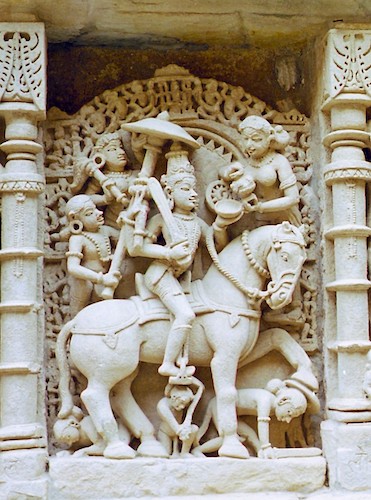
The fourth avatar that is depicted on the southern wall is that of Kalki, believed to be the 10th and future avatar of Vishnu. Kalki can be seen seated on a horse with a sword held in his right hand. A dagger is tied to his waist, and interestingly he is depicted wearing knee-length boots, similar to the depiction of Surya at the Modhera Sun Temple. Kalki can be seen wearing a crown and shielded by a parasol held by attendants. He holds a bowl in one hand to which a woman can be seen pouring something from a pitcher.
These are the 4 sculptures depicting avatars of Vishnu on the southern wall. There is a niche that is empty and in another niche is a beautiful sculpture of the Goddess Mahishasuramardini or Durga.
Mahishasuramardini
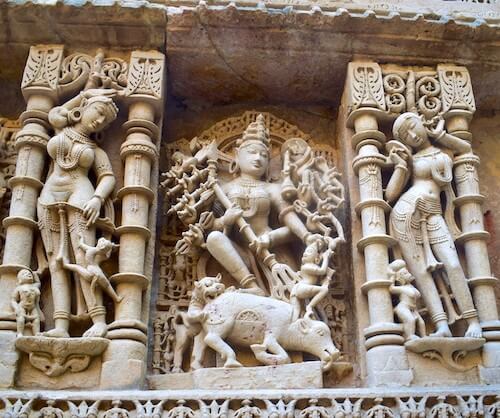
Durga is represented majestically as Mahishasuramardini. The Goddess with 10 pairs of hands is depicted slaying the demon Mahisha. The sculpture shows beautiful details including what is held in each of the 20 hands of the Goddess. The ten right hands of the Goddess can be seen holding a thunderbolt, trident, mace, arrow, goad spear, lotus, discus, kettle-drum, and sword. Her ten left hands hold, shield, bell, fish, skull cup with a fish, war horn, cobra, noose, bow, the shaft of the trident, and the demon’s hair.
The sculpture depicts the demon in the form of a buffalo lying supine beneath the feet of the Goddess. The human form of the demon can be seen emerging with a sword to fight on, his hair is held tightly by one of the hands of the Goddess. The lion of Goddess Durga is also shown as attacking the buffalo from the rear. This is one of the most stunning sculptures that you will see at Rani Ki Vav.
If you manage to tear your gaze away from the stunning sculptures that adorn the southern wall and turn towards the northern wall, you will see some more beautiful sculptures depicting different Vishnu avatars.
Vamana
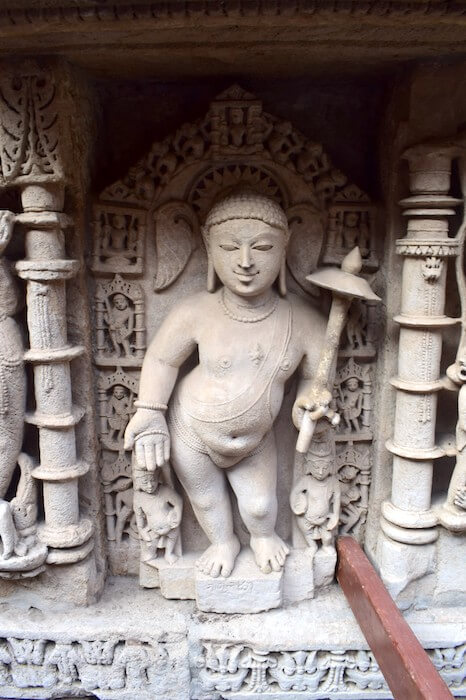
The Vamana avatar of Vishnu is that of a young Brahmin boy. The sculpture depicts a short and rotund boy. He is clad in a loincloth and wields an umbrella in one hand and a mala or rosary beads in the other. He has curly locks of hair and an enigmatic smile plays on his lips. On his chest can be seen the Srivatsa mark, which is a mark found on Vishnu’s chest, where his consort Goddess Lakshmi resides.
Varaha
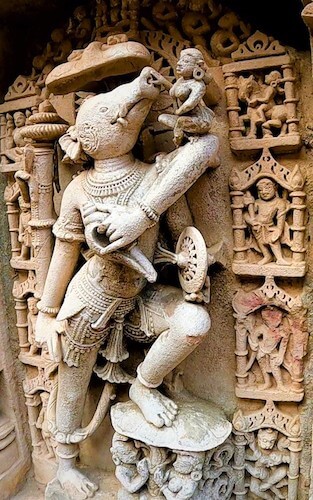
A beautiful sculpture is that of Vishnu as Varaha, rescuing Bhudevi from the bowels of the cosmic ocean where she has been hidden after being kidnapped by the demon Hiaranyaksha. This is a famous episode from the Hindu Puranas and has been widely depicted in many places. This is similar to the massive Varaha panel in the Udayagiri Caves near Sanchi in Madhya Pradesh.
The sinuous and massive figure of Varaha, with a human body and the head of a boar, dominates the niche. He holds a conch, discus, and mace, in each of his three hands, while the fourth hand rests by his side. This contrasts with the delicate and vulnerable figure of the Goddess Bhudevi, who is depicted as being seated on one of Varaha’s elbows and caressing his snout.
Rama
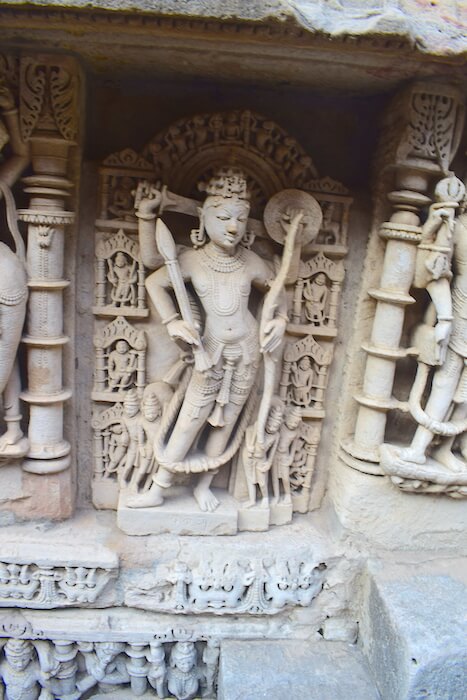
Rama, Vishnu’s avatar in the Treta Yuga, is depicted in a rare sculpture. He is shown with four hands. The hands hold a sword, an arrow, a slack bow, and a shield. Usually, Rama is usually depicted with two hands and with a bow, however, this sculpture of Rama in Rani Ki Vav is indeed a rare depiction of this avatar of Vishnu.
Bhairava
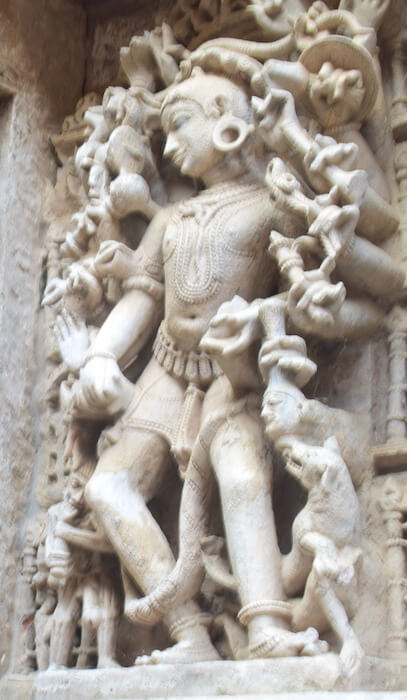
There is a fearful and majestic sculpture of Bhairava, who is a manifestation of Shiva. Bhairava is depicted with 20 hands. Each of his hands holds an object which includes a sword, thunderbolt, shield, goad, skull-cup, etc., one of his hands holds a decapitated head by the hair. His vehicle which is a wild dog called Shvan can be seen reaching up to lick the blood from the head that is held by Bhairava.
Nagakanya
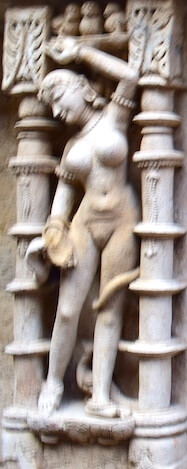
Apart from the sculptures in the main niches, there are beautifully sculpted forms of female figures that include Apsaras in various poses, mendicants, and others. These include seductive sculptures of Nagakanyas or Serpent maidens. These sculptures can be found on the projecting pillars that flank the main sculptures in the niches. The Nagakanyas are depicted nude with a serpent or two coiled around their legs. Here is a sculpture of a Nagakanya that can be seen flanking the sculpture of Varaha.
Female Mendicant
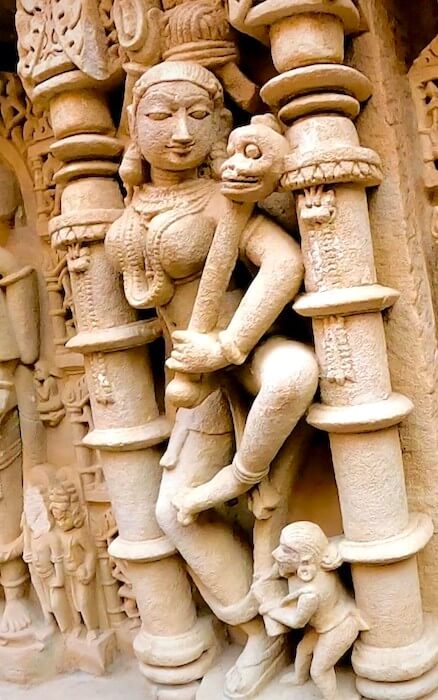
In addition to Apsaras and Nagakanyas, there are sculptures that depict strange-looking women who wear ornaments made of bones and carry skull-cups or clubs made of human skulls. It is conjectured that these women could represent unknown cults and were a common sight in the region in those times. A fascinating aspect to note in this particular sculpture is the footwear that is visible on the right foot of the female figure.
Sculptures of Gods With Their Consorts
Some other interesting sculptures that you must see in Rani Ki Vav, are those that depict some of the Gods of the Hindu pantheon, with their consorts. So you can Brahma with Saraswati, Vishnu with Lakshmi, Shiva with Parvati, and so on.
Famous Patola Designs In Rani Ki Vav
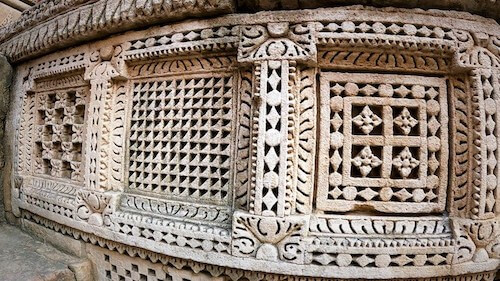
Patan is world-renowned for its famous Patola saris. You will be awed by the beautiful geometric designs that are carved on the walls of Rani Ki Vav.
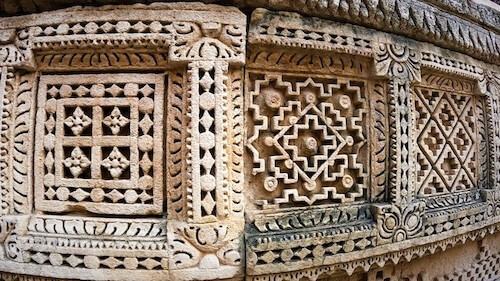
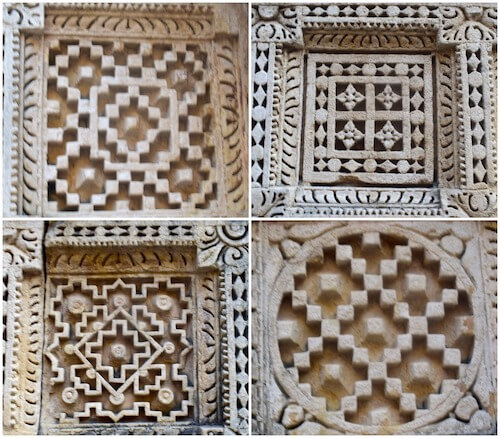
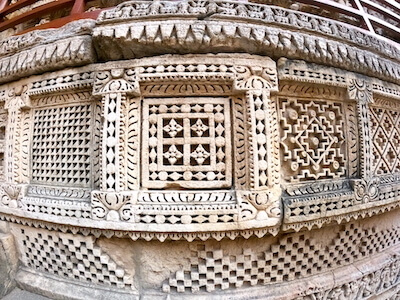
These designs resemble designs that you will find woven in Patola Saris, to this day.
Rani Ki Vav, Gujarat – Facts | Rani Ki Vav, Gujarat – Information | Rani Ki Vav Timings
- Rani Ki Vav is featured in Indian currency on a 100 Rupee note
- Rani Ki Vav is a woman’s tribute to her husband
- Not all portions of Rani Ki Vav is accessible to visitors
- Photography is allowed at Rani Ki Vav, however, tripods are not allowed
- Rani Ki Vav timings are from 8.00 AM to 7.00 PM, however, check for updated timings before going
- Tickets are priced at INR 40 for Indian citizens and INR 600 for foreign nationals
- Entry to Rani Ki Vav is free for children below the age of 15
- The best time to visit Rani Ki Vav is during the winter months from October to February
- You would need at least 2-3 hours to visit the Rani Ki Vav Patan
Rani Ki Vav Images
Here is a collage of Rani Ki Vav photos.
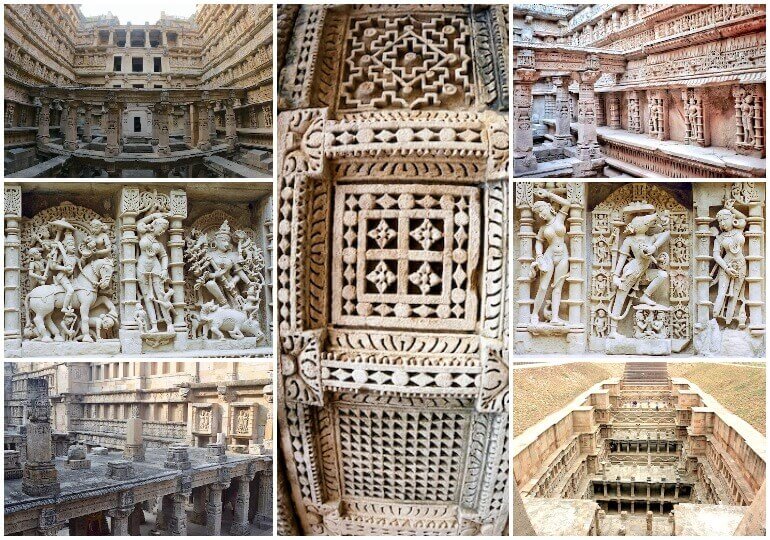
The images of Rani ki vav will surely make you plan a visit and experience the beauty in person.
How To Get To Rani Ki Vav Stepwell
If you are planning to visit Rani ki vav in Patan, Gujarat, then the below-mentioned information will help you plan your trip at ease.
Rani Ki Vav Location
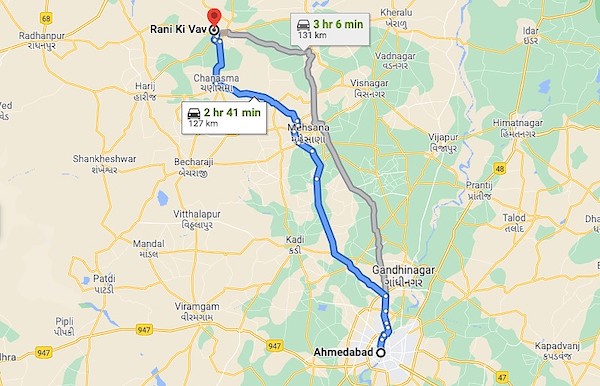
Rani Ki Vav Address
Mohan Nagar Society,
Mohan Nagar Society,
Patan, Gujarat 384265
Rani Ki Vav Contact Number
+91-2766291492
- Rani Ki Vav Rani Ki Vav Patan Gujarat is at a distance of about 128 kilometres
- The distance of Rani Ki Vav from Mehsana is about 54 kilometres
- The distance of Rani Ki Vav from Gandhinagar is about 113 kilometres
Getting To Rani Ki Vav Patan By Air
The nearest airport to Patan is the Sardar Vallabhbhai Patel International Airport in Ahmedabad, at a distance of about 122 kilometres. Ahmedabad is well connected to national and international centres. You can fly to Ahmedabad and travel by road to Patan, either by hiring a cab or by bus operated by GSRTC (Gujarat State Road Transport Corporation).
Getting To Rani Ki Vav Patan By Rail
The nearest railway station to Rani Ki Vav in Patan is Mahesana Junction. The distance is about 55 kilometres. If you prefer train travel, you can travel till Mehsana and then proceed by road.
Getting To Rani Ki Vav Patan By Road
A good network of roads connects Patan to other parts of Gujarat. You can easily travel from anywhere by road to Patan including Ahmedabad and Gandhinagar.
If you planning to visit Rani Ki Vav, Patan – The Queen’s Stepwell, you can book your flight tickets right here through Air India (Domestic) or Air India (International), or Priceline and fly to Ahmedabad. If you are thinking of a road trip from Ahmedabad, do check out the rental car and bus options.
Where To Stay When Visiting Rani Ki Vav Patan Gujarat
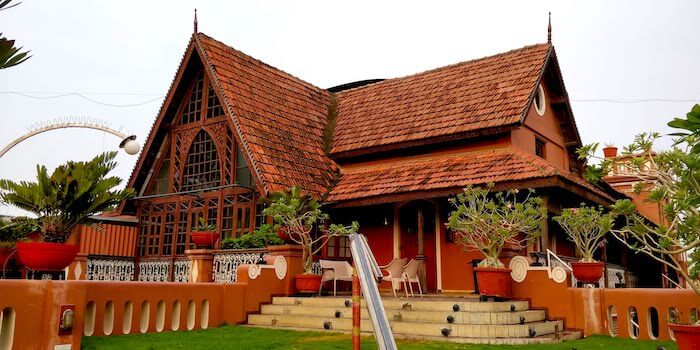
There are stay options in Patan as well as Mehsana. You also have the option of staying in Ahmedabad or Gandhinagar in any of the hotels according to your budget and preference. If you want to experience a slice of the rich heritage of Ahmedabad, you can stay at the House of MG. If your preference is a contemporary business hotel, Fortune Landmark on Ashram Road is a good option.
If you want to stay in Gandhinagar, there are many options including the Gift City. You can also choose to stay in Mehsana or Patan.
You can book Hotels in Ahmedabad, Gandhinagar, Mehsana, Patan or any destination right here through any of the options – TripAdvisor or Hotels.com or HotelsCombined and save a lot by getting the best deals on booking your stay.
| Click to book the best hotels in Ahmedabad or the best hotels in Gujarat |
|---|
Book A Day Trip To Patan From Ahmedabad
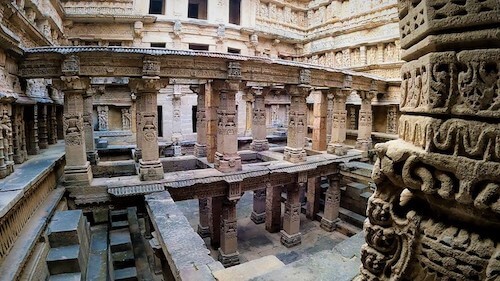
If you wish to have a guided tour from Ahmedabad to the beautiful Rani Ki Vav in Gujarat, then you may choose one of these tours:
- Click to book Patan and Modhera Sightseeing tour from Ahmedabad
- Click to book Private Tour: Patan Modhera Day Trip from Ahmedabad
- Click to book Private Tour of Stepwell, Modhera Sun Temple & Patola saree weaving by car
Travel Around Gujarat
There is so much to see and experience in Gujarat. If you prefer package tours and looking for these, you can plan your Gujarat itinerary and book your Gujarat trips, right here. So go ahead and book online places to see in Gujarat and popular activities in Gujarat and cover attractions in Gujarat.
| Click here to know more and book Gujarat Best Attractions in Gujarat |
|---|
Rani Ki Vav Patan Gujarat – FAQ
Why Rani-ki-Vav is famous?
Rani Ki Vav is a UNESCO World Heritage site known for its beautiful sculptures and architecture.
Rani ki Vav was constructed during the reign of which dynasty?
It was constructed during the reign of the Solankis also referred to as Chaulukyas.
Who built Rani-ki-Vav? Who made Rani ki Vav?
Rani Ki Vav is believed to have been built by the queen Rani Udayamati in memory of her husband King Bhima I.
Where is Rani-ki-Vav in which state?
Rani Ki Vav is located in the western state of Gujarat in India.
How was Rani-ki-Vav discovered?
Rani Ki Vav was submerged under sand owing to a flood and silting, it was discovered and restored by the Archaeological Survey of India.
Who declared Rani-ki-Vav an approved site?
Rani Ki Vav was declared a UNESCO World Heritage Site in 2014.
What is the shape of Rani-ki-Vav?
The Rani Ki Vav has a rectangular shape with the well towards its western extremity.
On which currency can we see the portrait of the Rani ki Vav?
The picture of Rani Ki Vav is printed on the 100 Rs note of Indian currency.
How many storeys does the Vav have?
The Rani Ki Vav Patan consists of 7 storeys.
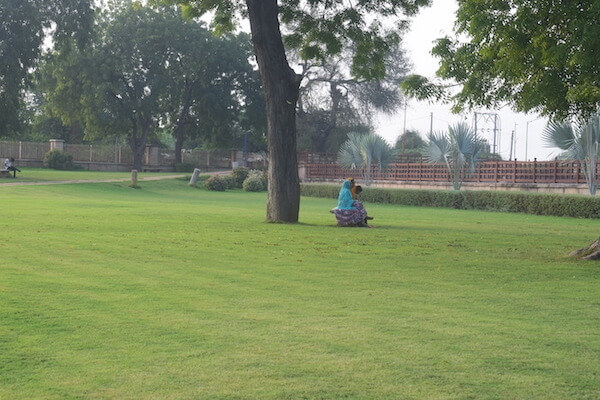
We look back at the Rani Ki Vav as we make our way back across a well-laid out a pedestrian path to the exit. Set amidst the sprawling garden, the Queen’s stepwell looks so deceptive in appearance.
Looking at it, one can scarcely believe its roller-coaster history. Its journey from grandeur to being buried under the ground for centuries, to be re-discovered and resurrected, to figure in the country’s currency and to be listed as a UNESCO World Heritage Site.
However, if Rani Ki Vav were to speak today, it would surely say that the best encomium for it would be for visitors to respect its antiquity and art. For visitors to admire it, but not to touch its fragile sculptures and interiors, to photograph it, but not desecrate it.
We are sure the beauty of the Queen of Stepwells has stirred your imagination and you are rearing to get there. We hope our Rani Ki Vav blog post helps you plan your own visit and provides you with the necessary information. Do get in touch for any more details or assistance. In the interim, do subscribe to our blog and connect with us on our social media channels.
Our visit to Rani Ki Vav, Patan in Gujarat was part of a familiarization trip organized by India Tourism Mumbai – Ministry of Tourism, Government of India and Gujarat Tourism under the #DekhoApnaDesh initiative. The views and opinions expressed in this blog post are our own. #Patan #RaniKiVav #ExploreGujarat #Gujarat #GujaratTourism
We are a reader-supported site. This means, at no additional cost to you, we may earn a small commission if you book a flight or hotel, or make a purchase through one of our affiliate links. Thank you for your support!
Flights – Air India (Domestic) or Air India (International), or Priceline
Tours – Click to book top tours around the world. Book tours and activities here.
Experiences – Book your next unforgettable experience here, with flexible bookings and free cancellations. Reserve tours and activities now and pay later.
Hotels – Click to book the best hotels/resorts. Choose the best stay options with TripAdvisor or Hotels.com, or HotelsCombined
Travel Insurance – Click to book Travel Insurance that covers a range of travel insurance and safety services including medical emergencies, lost luggage, trip cancellation and more
Visas and Travel Documents Application – Click here for Online Travel Visa Check
Online Passport Photo – Get Your Passport Photo Online here
Do You Love Traveling?
Do you want to know how to travel the world? We have put together a very useful travel resources page with the best travel tips. Go check it out now. Thanks for visiting our site Voyager - imvoyager.com and taking the time to read this post! If you wish to collaborate/work with us then reach us at [email protected] We’d love it if you’d comment by sharing your thoughts on this post and share this post on social media and with your friends. Follow our journey on our social media channels: Facebook X Instagram Pinterest YouTube
Start dreaming about your next adventure with Tripadvisor. Book your next unforgettable experience here with flexible bookings and free cancellations.
Flight booking online at the best fare
60+ Million Users Trust TripAdvisor With Their Travel Plans. Shouldn't You?
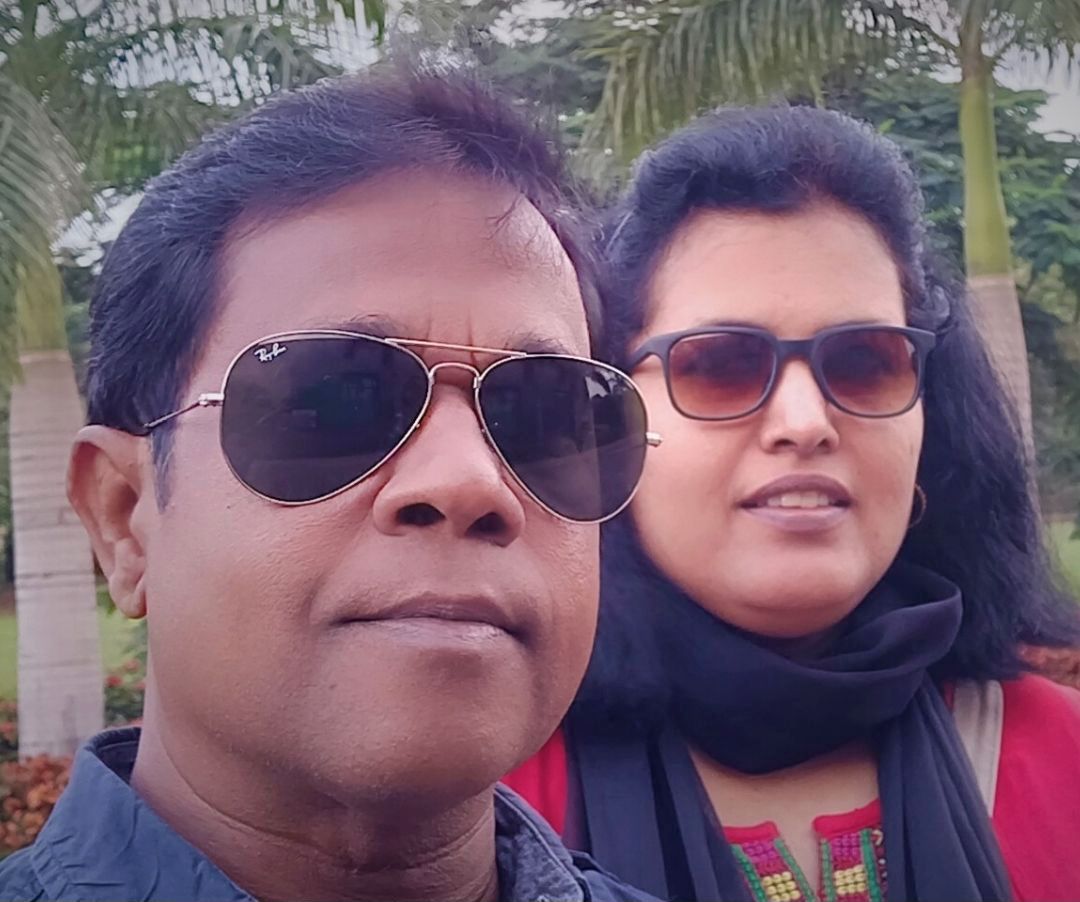
Sandy & Vyjay are a husband and wife duo who are travel content creators. They are co-founders of this travel website and are one of the leading travel content creators in India.
Sandy & Vyjay quit their successful corporate careers to pursue their passion for travel and writing full-time. Their dedication has earned them the “Best Travel Writer” award and numerous accolades on both national and international stages. Focusing on India’s destinations, heritage, and culture, they are passionate advocates for nature and the environment. Through their content, they promote ecotourism and sustainable travel, inspiring others to explore and preserve the beauty of India.
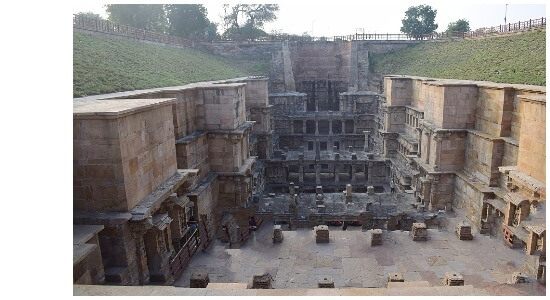
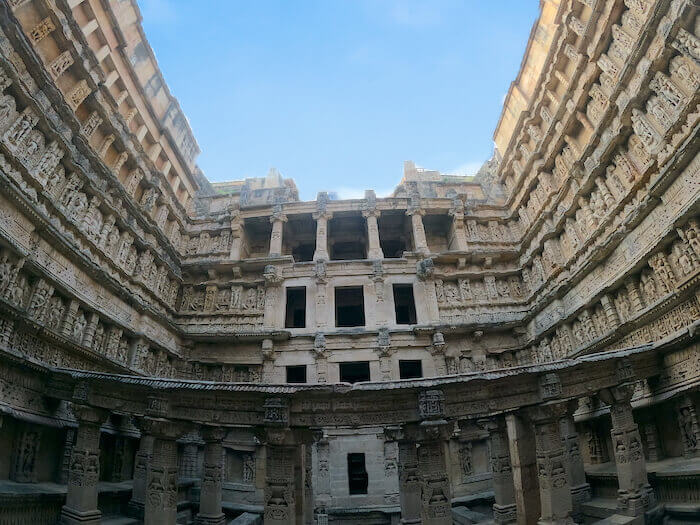
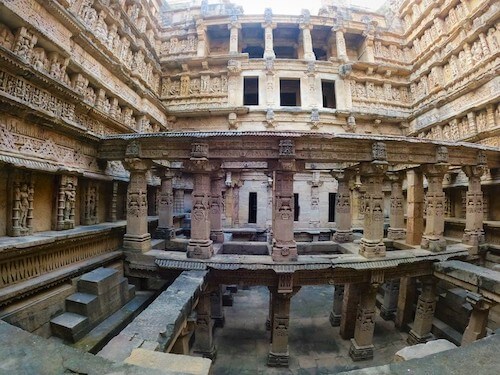
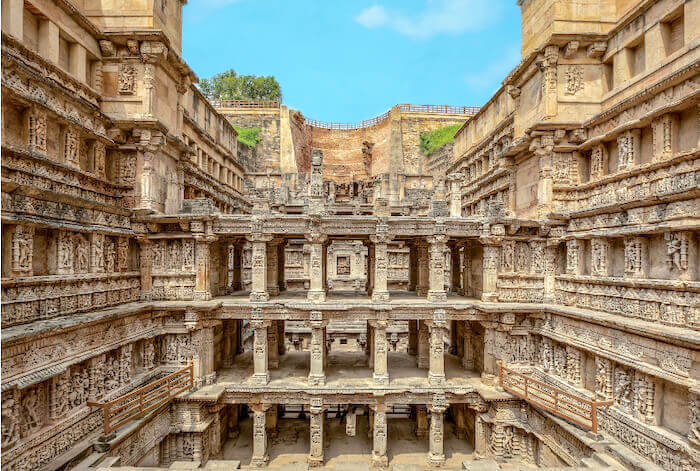

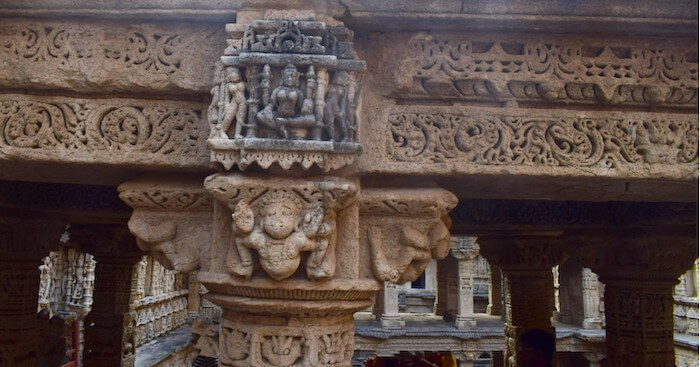

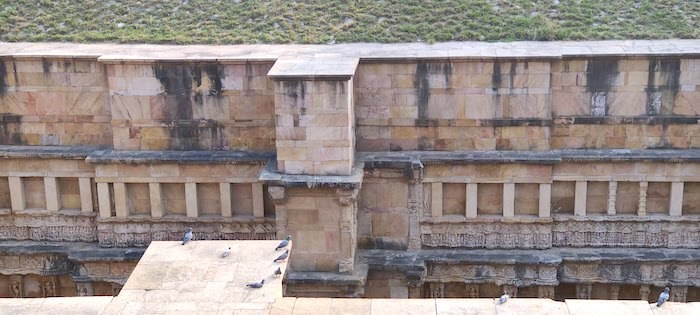
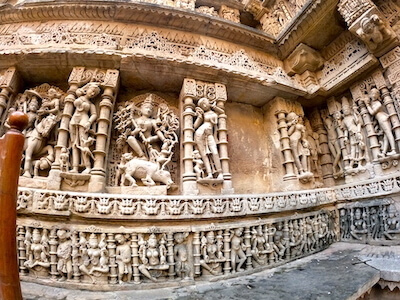
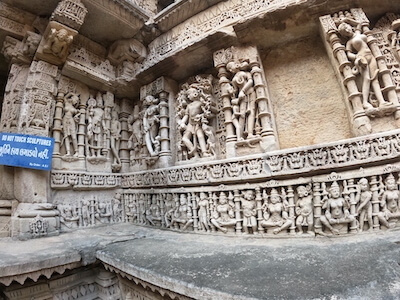

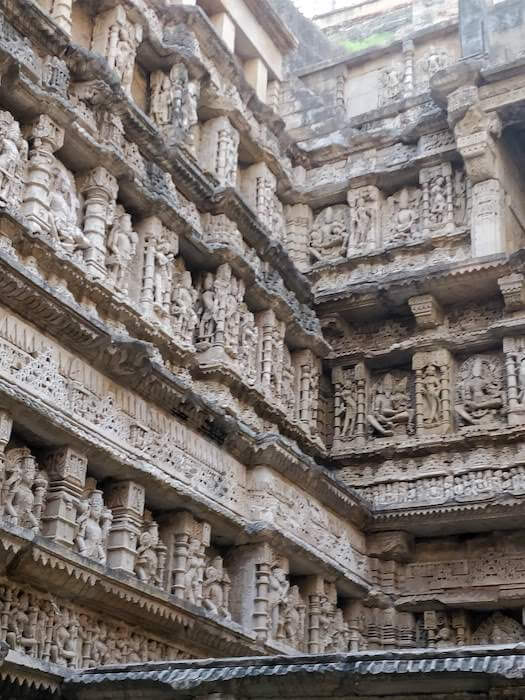
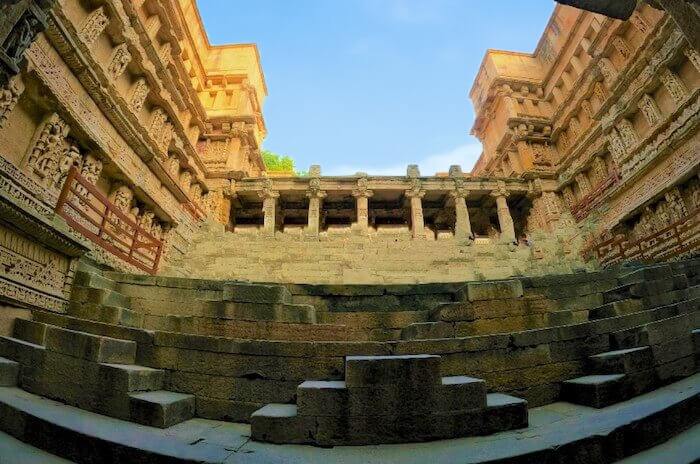
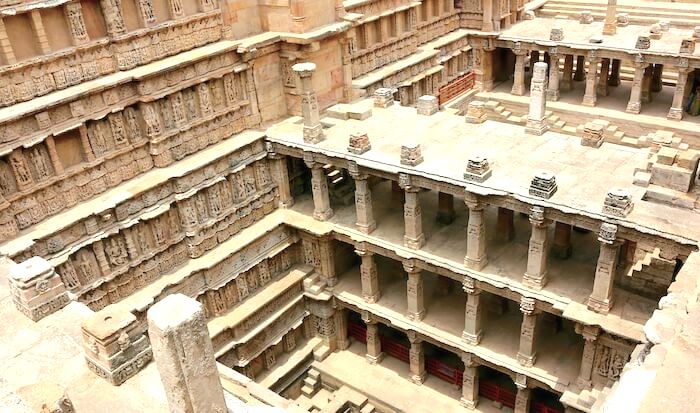

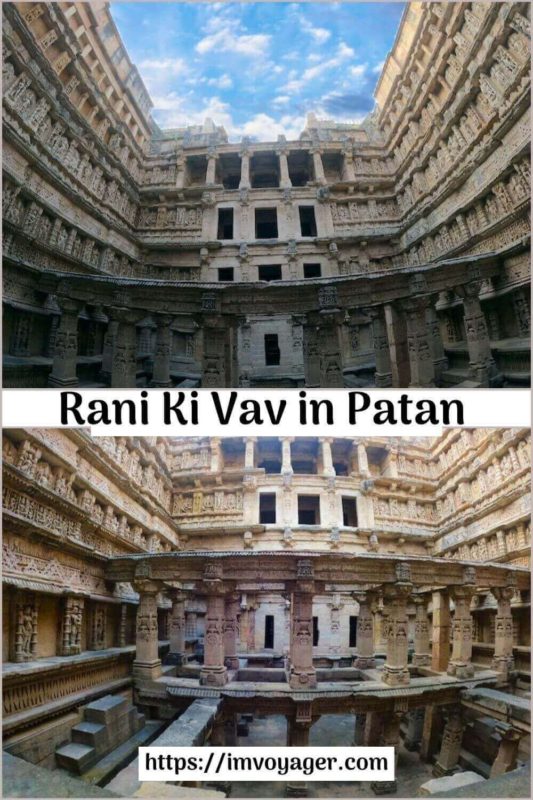


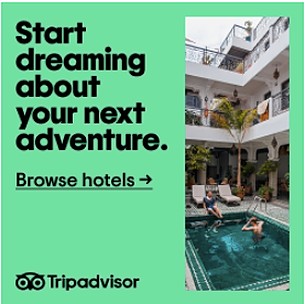



This is so impressive! I love all the carvings. I hope I can visit one day.
Wow, the history is so interesting, and the images are awesome! Can you imagine how the queen Rani Udayamati felt after seeing the Rani-ki-Vav built?
I hope that if I ever get to visit, I have a guide that is as knowledgeable as you.
A tour of Rani Ki Vav Patan Gujarat looks like such an amazing experience.
I love visiting places that have a rich history. I’d love to see the beauty of the Queen of Stepwells
It is devastating to have your tribute to your husband swallowed up by the earth, even if it was long after your death. It is quite amazing how the sand preserved it, though.
This is an interesting place to visit, and the architectural designs are amazing!
Rani Ki Vav seems like such a wonderful place to visit. Lots of attention to detail on the sculptures.
I would love to travel more and see places like this in person someday. Great article!
That does look like a very beautiful place. What an amazing experience that must be. I’d love to see all this someday.
This is brilliant post dear, beautiful piece of art it is. You have clicked it amazingly. My son is very fond of watching videos and reading about temples. This is worth sharing with him. He will surely love it.
Wow! This is such a really amazing and a wonderful place to visit! I really love this!
Oh my! I’m sure this will going to be a very awesome experience. I really wanted to visit this really wonderful place!
This is such a beautiful destination. Would love to visit this location some day
This virtual tour of Rani ki vav was a wonderful experience. Loved the detailed carvings. And House of MG also looked very welcoming. I am sure, if I ever visit this place, I am surely going to remember your blog.
wow such a wonderful historic place, they have so much detail! Such a great experience
Stepwells are such a beautiful concept. I haven’t visited one yet but will for sure soon! The pictures you have posted are stunning and I love how detailed this post is
Wow I did not know that more there are more than 120 stepwells in Gujarat. Rani ki vav seems like an excellent historical place with impressive infrastructure. would surly love to visit this place someday with my family.
Such beautiful pictures and a place that I would love to visit and tour for myself. The architecture and detailed carvings are breathtakingly beautiful and I must add Rani ki Vav to my bucket list for sure.
The architecture is indeed magnificent. Glad to know that’s it’s UNESCO heritage site.
Would love to explore Gujarat & visit Rani ki vav.
How fascinating! It is like an inverted temple, that’s amazing. I loved this stepwell and the stunning architecture it has. I did not visit it the last time when I was in Gujarat, but now have added Rani Ki Vav Patan to my list and will surely go there the next time.
This place is a stunner. I always get fascinated by these step well, the purpose for which these are made and the way whole thought process must have gone behind. I have seen one which is in Ahmedabad but this one is truly amazing.
Oh I bet this is breathtaking to see in person. Thank you so much for sharing all of these awesome shots and info!
I live in Ahmedabad but I feel there are so many places in Gujarat which I haven’t even heard of. If I became full time traveller then also it will 3-4 years to explore whole Gujarat. Thank you for letting me know about this beauty in Patan.
This is an architectural marvel Indeed. Back in those time creating such a wonderful and intricate work on the walls n pillars is just so amazing to see.
Rann of Kutchh has been on my bucket list for so long and being here is Vadodara I am just waiting for the third wave to subside. I really need to appreciate the value you bring in to your blog post by making them exhaustive in all respects.
I said Rann of Kutch because I have plans to go Rani ki Vav after Kutch on the sam trip.
I’m in awe with this architectural wonder. The first time in see a queen building something in memory of her husband. Glad that ghe site is well preserved for visitors
I have been to this place . Very beautiful place with lots of history and close to nature. Love your in-depth review on it.
I am awestruck to see the architectural beauty of Rani Ki Vav. What a rich country we are living in. A paradise .